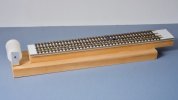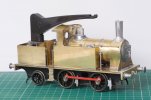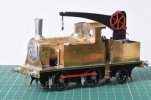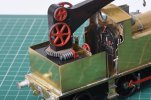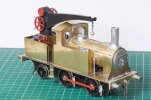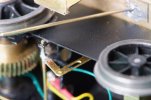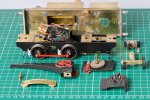Richard Gawler
Western Thunderer
Simon thank you for all of your comments. For the time being . . .
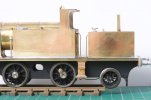
The rear axle can drop like this. It can also rise more than 0.75 mm above the drivers (measured with a strip of styrene) but this is harder to photograph.
When I arranged this, one of my thoughts was that this rear axle shouldn't interfere with a rocking axle at the front.
I don't know how many wheels are on the track at the same time. I want to think always four, usually five. These being three of the drivers and one or both of the trailing wheels. Suppose I arrange some pickups on the trailing wheels and connect the motor to only these, I would find out how much wheel/rail contact there really is at the rear axle. I imagine, if only one driver of a pair is touching its rail then the loco will have a desire to yaw, but maybe this is for only a fraction of a second.
To be honest, the haulage capacity of Nellie is more than adequate for me. If she goes out onto the main line with a tender truck, an open wagon and a brake van this would be fine for me. Still, the more I learn from this the more I will know before I begin my next loco.
I should emphasise - I don't have any aversions to compensation, but this is my first 7 mm loco kit and I have been cautious with the driving wheels.
Edit: and after looking at this photograph I need to go and find at least one crank pin bush
I suspect you have, at least at times, only three wheels in contact with the track, and maybe only one of them is a driver.
The rocking axle will improve matters but only usefully if the trailing axle isn’t holding the middle axle off the rails.

The rear axle can drop like this. It can also rise more than 0.75 mm above the drivers (measured with a strip of styrene) but this is harder to photograph.
When I arranged this, one of my thoughts was that this rear axle shouldn't interfere with a rocking axle at the front.
I don't know how many wheels are on the track at the same time. I want to think always four, usually five. These being three of the drivers and one or both of the trailing wheels. Suppose I arrange some pickups on the trailing wheels and connect the motor to only these, I would find out how much wheel/rail contact there really is at the rear axle. I imagine, if only one driver of a pair is touching its rail then the loco will have a desire to yaw, but maybe this is for only a fraction of a second.
To be honest, the haulage capacity of Nellie is more than adequate for me. If she goes out onto the main line with a tender truck, an open wagon and a brake van this would be fine for me. Still, the more I learn from this the more I will know before I begin my next loco.
I should emphasise - I don't have any aversions to compensation, but this is my first 7 mm loco kit and I have been cautious with the driving wheels.
Edit: and after looking at this photograph I need to go and find at least one crank pin bush


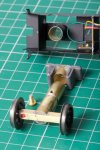
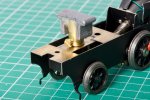
 .
.